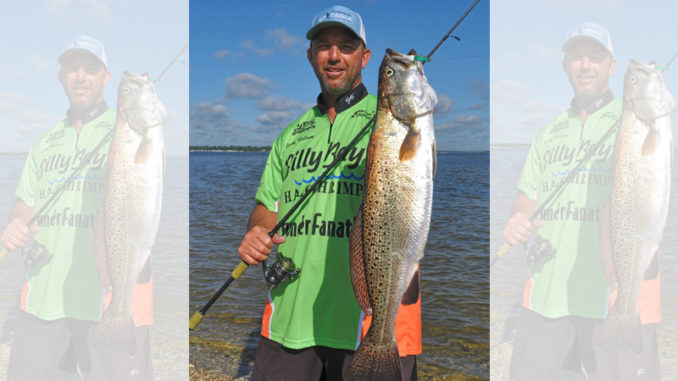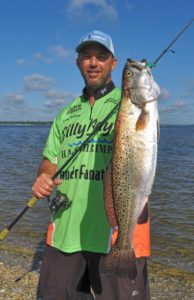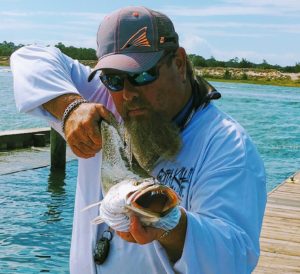
When it comes to specks, you can’t go wrong following the advice of four veteran guides who know their home waters and how to fish them.
November along the North Carolina coast is a magical time to fish for spotted seatrout, aka speckled trout, because of one overriding factor: water temperature.
That’s one thing that four saltwater guides — Noah Lynk of Harker’s Island, Dale Collins of Swansboro, Ricky Kellum of Jacksonville and Jot Owens of Wilmington — all agree on.
With North Carolina’s coast being running from 33.76 degrees north latitude at Sunset Beach to 36.61 degrees north latitude on the Currituck Banks, saltwater temperatures may vary widely in state waters. That means trout can be found looking for food behind barrier islands or in the ocean. Here’s how the four guides target trout in their home waters.
Cape Lookout area
“Water temperature and tides are the two things that affect fishing the most around where I live,” said Lynk, 47, who operates Noah’s Ark Fishing Charters. “Temperature affects where shrimp, baitfish and specks live in November. Will they be inside if it’s warm or move to inlets or the ocean if it’s cold? Temperatures tell me where to fish.”
One of his favorite places for early-November specks is the North River near Beaufort.
“They’ll be in 2 or 3 feet of water,” he said. “If it gets cold really fast, everything leaves; it’ll be dead up there. But as soon as it warms up, shrimp and trout come back a day or two later. Or, if we have sustained cold, they stay outside.”
When fishing shallow water, Lynk (252-342-6911) likes MirrOlures — but not suspending twitch baits.
“I use MirrOlure Little Johns and Marsh Minnows,” he said. “A Little John looks like a bullet. You’d think someone would’ve invented (one) years ago; it’s as low-tech as you can get.

“I use it with a ¼-ounce jighead. You can trim them to 1½ or 2 inches long, and they’ll dart all over the place when you pop ’em off the bottom, like a baitfish that’s been whacked on the head and tossed overboard. Trout can’t resist it. A Marsh Minnow has a paddletail and really cuts up in the water, too.
“I cast and let ’em drop back in current and pop ’em up. Yeah, they’re small, but elephants eat peanuts.”
Lynk also uses scented Fishbites Fight Club lures, including 3-inch curlytails, 4-inch paddletails, 5-inch jerkbaits and the 3½-inch Fight’n Shrimp. He fishes everything on a 7-foot, medium-light Star spinning outfit spooled with 12-pound braid with an 18-inch fluorocarbon leader.
Cape Fear East
Owens, owner of Jot It Down Fishing Charters, hunts specks at inside channels and creeks that connect to inlets from Carolina Beach to Topsail Island.
“Early in the month, water (temperatures) can be from the upper 50s to upper 60s,” said Owens (910-233-4139). “But when it gets lower than 52 degrees, specks get harder to catch inside. In my experience, the best November temperature for trout is 55 to 62 degrees. Double-digit specks get caught then, not a lot, but the possibility goes up. Plus, most trout you catch will be strong 2- to 5-pounders.”
On his best November trips, Owens said his parties will catch 70 trout.
“All were keeper sizes, too,” he said. “Two Novembers ago, (one of his clients) caught a 9½-pounder. I told them they’d never see another trout like that in their lives. A few minutes later, they caught an 8-12.”
Both trophy specks came off an oyster bank near a channel leading to an inlet. They smacked a MirrOdine 17MR-808, a 25/8-inch suspending twitch bait.
For light lures, Owens uses 7-foot, light-action rods with 1000 to 2000 series spinning reels. For larger lures, he mates 2500 to 3000 series reels to 7-foot, medium-action rods.
“In shallow water, I use MirrOlure 17MRs and Catch 2000 Juniors. For deep water, I use MR18s, 52Ms or 52MRs,” Owens said. “I also like darker lure colors in (stained) water and lighter colors in clear water.”
If the artificial lure bite slows, he may employ live baits with float rigs in shallow water.
“I like a slider or clip-on rig with No. 6 red or black treble hooks tied to 2 feet of 20-pound fluorocarbon (leader),” Owens said, “sometimes with a small split-shot above the bait. But if I’m fishing deeper, I may use a small egg-sinker Carolina rig with 3 feet of 20-pound fluorocarbon leader, so the bait can sink naturally.”
New River
Kellum, 51, has a well-earned reputation as one of North Carolina’s top trout guides, having fished for most of his life on the New River, which has been known to give up plenty of gator specks.
“The river is getting better than ever,” said Kellum, who owns The Speckled Specialist Fishing Charters.
Unlike most coastal streams, the New has a year-round supply of live shrimp, an advantage for Kellum’s novice anglers. He likes to hand them a slip-cork rig fish in channels near bridges on a falling tide. Otherwise, he sticks to slow-sinking artificial lures: his favorite Betts Billy Bay Halo Shad and signature Perfect Sinker Shrimp.
“But if trout are hitting surface lures, it’s hard to beat a bone-colored Zara Spook Jr. in clear water or a red head/chartreuse-body model upriver,” said Kellum (910-330-2745), who replaces the factory hooks with No. 4 4X trebles because “No. 2 and No. 4 trebles are wire, and a big redfish or striper can bend ’em. You won’t lose fish with No. 4 4X trebles made for king mackerel baits.”
If bluefish are plentiful, he likes a MirrOlure MR17 twitch bait in electric-chicken or the new 3 1/8-inch MirrOdine 27MRBG-51SBG with reflective sides that mimics a menhaden.
Swansboro
Dale Collins sits in the catbird seat of North Carolina’s central coast, with Lynk to his north and Kellum and Owens to his south.

But Collins, 49, who operates Fish or Die Charters, wouldn’t trade places with the other three guides because he has so much prime water to fish, including the White Oak River, Bear, Bogue and Browns inlets and the back sides of Bear, Browns and Bogue islands, Hammocks Beach State Park, the Bogue Sound and hundreds of marsh islands and creeks, plus four large highway bridges.
“In a normal November, specks move up creeks into deep holes,” said Collins, who runs the tackle shop at Dudley’s Marina at Cedar Point. “I really slow-fish 3¾- to 5-inch soft plastics on light jigheads from the shoreline out on falling tides and from the middle of a creek in on rising tides or with MR18 MirrOlures.”
Collins (252-422-4326) likes November because bait-stealing “trash” fish like pinfish and hogfish have left for the ocean. That lets him rig Billy Bay popping-cork rigs with live shrimp or mud minnows.
“Small specks show up near inlets, but if the water’s really salty, bigger trout move up the rivers and into backs of creeks so far you can hear banjo music,” Collins said.
That’s when Collins breaks out artificial lures, including a 3½-inch D.O.A. Golden Bream shad-tail grub or a gold Z-Man paddletail or fluke on a 1/16-ounce Blue Water Candy jighead. He also may use a 4-inch Gulp swim mullet or shrimp.
“Most specks will be 2 to 5 pounds, but you can catch 6-pounders,” he said.
In deeper water, he’ll cast and retrieve MirrOlures MR18s after replacing the factory hooks with No. 6 VMC trebles custom-tied with feathers. He likes 7-foot, medium-light Star Seagis rods with 2500 Penn Conflict spinning reels spooled with 10-pound braid and an 18-inch leader of 12- to 15-pound pink Yo-Zuri fluorocarbon.
“I use a loop knot to tie to lures because it gives them a little more action,” Collins said. “I always look for a little swifter water with a deep trough nearby or oyster rocks with a deep ledge close by. Those places hold trout in November.”




Be the first to comment